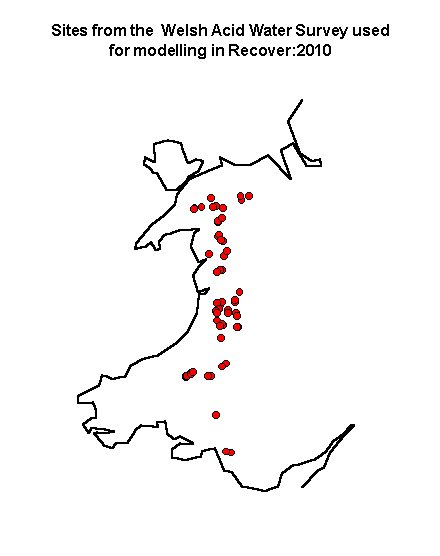PREDICTING RECOVERY IN ACIDIFIED FRESHWATERS BY THE YEAR 2010, AND BEYONDContract EVK1-1999-00087 - RECOVER:2010 Part of the 'Sustainable Management and Quality of Water' Ecosystem Functioning Directorate General Research |
|||||||||
|
Upland Britain - Wales
Large areas of Wales are vulnerable to acidification, especially the uplands, as the bedrock is slow weathering and the soils have little or no acid neutralising capacity (Hornung et al., 1990). It is estimated that 34% of soils in Wales are affected by acidic deposition and in these areas, about 50% of the first to third order streams may have been damaged. In terms of nature conservation, Wales is the worst affected region in the UK with more than 40% of the total area of Sites of Special Scientific Interest (SSSIs) potentially damaged by freshwater acidification (Stevens et al., 1997). Against this background and given a 52% reduction in UK sulphur dioxide emissions between 1980 and 1995, monthly stream chemistry surveys have been conducted across Wales during 1983-84 and 1995-96 to determine the degree of chemical change. The combination of high acid deposition fluxes and vulnerable geology gives the region its documented low critical loads and high exceedance compared to much of the UK.
Afon Mynach Catchment
 The sites used in this study extend over a large area of upland Wales, ranging from close to industrial areas on the south coast, to remote mountain catchments in Snowdonia in the north (Figure 1). Most sites are distant from major emission sources, although deposition is moderately high (non-marine sulphur deposition for 1992-94 15-30 kg S/ha/yr, total N deposition 16-24 kg N/ha/yr), in part due to high rainfall. The Cambrian Mountains occupy much of the study area,
extending from south-central Wales to the north coast, and are characterised by moderate relief (elevations mostly less than 600m) and acid-sensitive Lower Paleaozoic sedimentary geology. In the northwest, Snowdonia contains larger mountains, with maximum elevations exceeding 1000m, and is underlain by a mixture of acid-igneous and metasedimentary bedrock, much of which is also vulnerable to acidification. Soils are relatively uniform throughout the region, with peats widespread on hilltops, grading to ferric stagnopodzols, stagnohumic gleys and brown podzols at lower altitudes. Rankers are
also present in the more mountainous areas of Snowdonia. Land-use is predominantly either rough moorland or coniferous forestry plantation at higher elevations, with improved pasture prevalent in lower valleys.
The sites used in this study extend over a large area of upland Wales, ranging from close to industrial areas on the south coast, to remote mountain catchments in Snowdonia in the north (Figure 1). Most sites are distant from major emission sources, although deposition is moderately high (non-marine sulphur deposition for 1992-94 15-30 kg S/ha/yr, total N deposition 16-24 kg N/ha/yr), in part due to high rainfall. The Cambrian Mountains occupy much of the study area,
extending from south-central Wales to the north coast, and are characterised by moderate relief (elevations mostly less than 600m) and acid-sensitive Lower Paleaozoic sedimentary geology. In the northwest, Snowdonia contains larger mountains, with maximum elevations exceeding 1000m, and is underlain by a mixture of acid-igneous and metasedimentary bedrock, much of which is also vulnerable to acidification. Soils are relatively uniform throughout the region, with peats widespread on hilltops, grading to ferric stagnopodzols, stagnohumic gleys and brown podzols at lower altitudes. Rankers are
also present in the more mountainous areas of Snowdonia. Land-use is predominantly either rough moorland or coniferous forestry plantation at higher elevations, with improved pasture prevalent in lower valleys.

The 59 sites considered here are a subset of over 100 streams sampled monthly during the 1995 Welsh Acid Water Survey (Stevens et al., 1997). Catchments containing over 25% improved land, or located on non-sensitive geologies such as limestone, were excluded. Of the sites included, 35 have catchments containing over 10% forest. Most streams have a low positive ANC (Table 1), with negative mean values observed at 14 sites, and a minimum site mean of -38 µeq/l. Sulphate concentrations are moderately high (median 100 µeq/l), but nitrate concentrations are low at most sites (median 7 µeq/l). Concentrations of sea-salt ions are high in many streams due to their proximity to the coast.
Table 1: Summary statistics from the Welsh Region
| 10th Percentile | Median | 90th Percentile | |
| ANC | -9 | 22 | 101 |
| pH | 5.43 | 6.03 | 6.54 |
| SO4 | 68 | 100 | 196 |
| NO3 | 3 | 7 | 25 |
| Cl | 170 | 211 | 335 |
| NH4 | N/A | N/A | N/A |
All concentrations meq/l except for pH (pH units)
| Results from Wales |
| For more information contact: Cev@ceh.ac.uk |
| REGIONS |
References
Hornung, M., Le-Grice, S., Brown, N. and Norris, D. 1990. The role of geology and soils in controlling surface wtaer acidity in Wales. In: Acid Waters in Wales (R.Edwards et al. (Eds.) Kluwer Academic Publishers, Dordrecht, Netherlands.
Stevens, P.A., Ormerod, S.J. and Reynolds, B., 1997. Final Report on the Acid Waters Survey for Wales. Institute of Terrestrial Ecology, Bangor, UK.





